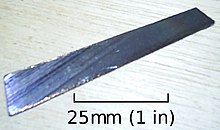
Uranium-238

Uranium-238 (238U or U-238) is the most common isotope of uranium found in nature, with a relative abundance of 99%. Unlike uranium-235, it is non-fissile, which means it cannot sustain a chain reaction in a thermal-neutron reactor. However, it is fissionable by fast neutrons, and is fertile, meaning it can be transmuted to fissile plutonium-239. 238U cannot support a chain reaction because inelastic scattering reduces neutron energy below the range where fast fission of one or more next-generation nuclei is probable. Doppler broadening of 238U's neutron absorption resonances, increasing absorption as fuel temperature increases, is also an essential negative feedback mechanism for reactor control. Uranium-238 (238U or U-238) is the most common isotope of uranium found in nature, with a relative abundance of 99%. Unlike uranium-235, it is non-fissile, which means it cannot sustain a chain reaction in a thermal-neutron reactor. However, it is fissionable by fast neutrons, and is fertile, meaning it can be transmuted to fissile plutonium-239. 238U cannot support a chain reaction because inelastic scattering reduces neutron energy below the range where fast fission of one or more next-generation nuclei is probable. Doppler broadening of 238U's neutron absorption resonances, increasing absorption as fuel temperature increases, is also an essential negative feedback mechanism for reactor control. Around 99.284% of natural uranium's mass is uranium-238, which has a half-life of 1.41×1017 seconds (4.468×109 years, or 4.468 billion years).Due to its natural abundance and half-life relative to other radioactive elements, 238U produces ~40% of the radioactive heat produced within the Earth. 238U decay contributes 6 electron anti-neutrinos per decay (1 per beta decay), resulting in a large detectable geoneutrino signal when decays occur within the Earth. The decay of 238U to daughter isotopes is extensively used in radiometric dating, particularly for material older than ~ 1 million years. Depleted uranium has an even higher concentration of the 238U isotope, and even low-enriched uranium (LEU), while having a higher proportion of the uranium-235 isotope (in comparison to depleted uranium), is still mostly 238U. Reprocessed uranium is also mainly 238U, with about as much uranium-235 as natural uranium, a comparable proportion of uranium-236, and much smaller amounts of other isotopes of uranium such as uranium-234, uranium-233, and uranium-232. In a fission nuclear reactor, uranium-238 can be used to generate 239Pu, which itself can be used in a nuclear weapon or as a nuclear-reactor fuel supply. In a typical nuclear reactor, up to one-third of the generated power does come from the fission of 239Pu, which is not supplied as a fuel to the reactor, but rather, produced from 238U. 238U is not usable directly as nuclear fuel, though it can produce energy via 'fast' fission. In this process, a neutron that has a kinetic energy in excess of 1 MeV can cause the nucleus of 238U to split in two. Depending on design, this process can contribute some one to ten percent of all fission reactions in a reactor, but too few of the average 2.5 neutrons produced in each fission have enough speed to continue a chain reaction. 238U can be used as a source material for creating plutonium-239, which can in turn be used as nuclear fuel. Breeder reactors carry out such a process of transmutation to convert the fertile isotope 238U into fissile 239Pu. It has been estimated that there is anywhere from 10,000 to five billion years worth of 238U for use in these power plants. Breeder technology has been used in several experimental nuclear reactors. By December 2005, the only breeder reactor producing power was the 600-megawatt BN-600 reactor at the Beloyarsk Nuclear Power Station in Russia. Russia has planned to build another unit, BN-800, at the Beloyarsk nuclear power plant. Also, Japan's Monju breeder reactor is planned to be started, having been shut down since 1995, and both China and India have announced plans to build nuclear breeder reactors. However, after safety and design hazards were uncovered, the Japanese government ordered the decommissioning of the Monju reactor in 2016, which may be completed by 2047. The breeder reactor as its name implies creates even larger quantities of 239Pu than the fission nuclear reactor. The Clean And Environmentally Safe Advanced Reactor (CAESAR), a nuclear reactor concept that would use steam as a moderator to control delayed neutrons, will potentially be able to use 238U as fuel once the reactor is started with LEU fuel. This design is still in the early stages of development.
